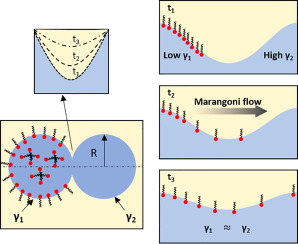Journal of Colloid and Interface Science ( IF 9.4 ) Pub Date : 2018-06-06 , DOI: 10.1016/j.jcis.2018.06.011 Jerome J. Nash , Patrick T. Spicer , Kendra A. Erk

|
Through several complementary experiments, an investigation of the bulk and interfacial flows that emerged during the coalescence of two water-in-oil droplets with asymmetric compositional properties was performed. By adding surfactant to one of the coalescing droplets and leaving the other surfactant-free, a strong interfacial tension gradient (i.e., solutal Marangoni) driving energy between the merging droplets generated pronounced internal mixing. The contributions of two distinct types of surfactant, anionic ammonium lauryl sulfate (ALS) and cationic cetyltrimethylammonium bromide (CTAB) on the rate of coalescence bridge expansion and on the generation of opposing flows during coalescence were investigated. All coalescence experiments supported the power law relation between the radius of the expanding connective liquid bridge and time, rb ∝ t1/2. However, the presence of surfactant decreased the magnitude of the prefactor in this relationship due to induced interfacial solutal Marangoni convection. Experiments showed that packing efficiency, diffusivity, and bulk concentration of the selected surfactant are vital in solutal Marangoni convection and thus the degree and timescale of internal mixing between merging droplets, which has yet to be adequately discussed within the literature. Denser interfacial packing efficiency and lower diffusivity of CTAB produced stronger opposing bulk and interfacial flow as well as greater bulk mixing. A discussion of how optimized surfactant selection and solutal Marangoni convection can be used for passively inducing convective mixing between coalescing drops in microfluidic channels when viscosity modulation is not feasible is provided.
中文翻译:

具有不同头基结构的表面活性剂的水溶性Marangoni对流引起的聚结液滴内可控的内部混合
通过几个补充实验,对两个具有不对称成分特性的油包水液滴合并过程中出现的体积流和界面流进行了研究。通过向一个聚结的液滴中添加表面活性剂而使另一个不含表面活性剂,在合并的液滴之间驱动能量的强大的界面张力梯度(即,水溶性的马兰戈尼)产生了明显的内部混合。研究了两种不同类型的表面活性剂,阴离子型十二烷基硫酸铵铵(ALS)和阳离子型十六烷基三甲基溴化铵(CTAB)对聚结桥膨胀速率和聚结过程中相反流动的产生的影响。所有合并实验均支持扩展的结缔液桥的半径与时间r之间的幂律关系b α吨1/2。然而,由于诱导的界面溶性马兰戈尼对流,表面活性剂的存在降低了这种关系中前因子的大小。实验表明,所选表面活性剂的填充效率,扩散率和体积浓度在Marangoni溶液对流中至关重要,因此,合并液滴之间的内部混合程度和时间尺度尚未在文献中进行充分讨论。Denser界面填充效率和CTAB较低的扩散性产生了更强的相反体积和界面流动,以及更大的体积混合。提供了关于如何在粘度调节不可行的情况下优化表面活性剂选择和Marangoni溶液对流的方法用于在微流体通道中的聚结液滴之间被动诱导对流混合的讨论。











































 京公网安备 11010802027423号
京公网安备 11010802027423号